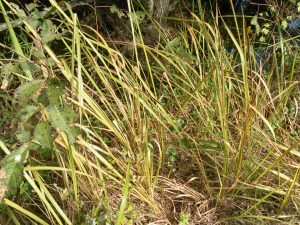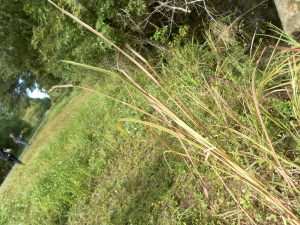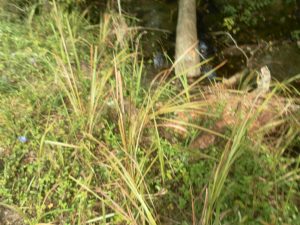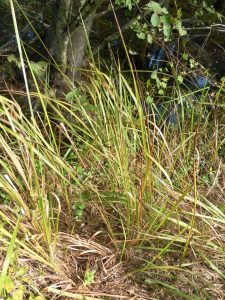Imperata cylindrica (cogongrass)

Imperata cylindrica is one of the top ten worst weeds in the world due to its extensive rhizomes, prevalence in poor soils, drought tolerance, genetic plasticity and fire tolerance (Starr et al. 2008). Imperata cylindrical, commonly called cogongrass or japgrass, bloodroot grass and Red Barron, is a member of the Poaceae family (Miller 2003, Wunderlin and Hansen 2008). It is native to Southeast Asia and was introduced into the United States in the early 1900s for the purpose of stabilizing soils (Miller 2003). However, it has since spread throughout the southeastern United States including Florida, Louisiana, Alabama, Mississippi and Georgia (Miller 2003, MacDonald et al. 2008). Originally, cogongrass escaped from a crate of oranges into Mississippi in 1912 (MacDonald et al. 2008). It was then was intentionally introduced as a forage crop into Mississippi and introduced into Florida in the 1930s and 1940s for soil stabilization as well as for forage (MacDonald et al. 2008). In Florida, the weed has thrived and invaded natural communities throughout the state, putting it on Florida’s Noxious Weed List, Florida Prohibited Aquatic Plants List and a Category I on the Florida Exotic Pest Plant Council’s 2011 list (MacDonald et al. 2008).
Imperata cylindrica can grow in a variety of habitats that range from full sun to some shade, including many open forests, coastal lands, riparian zones, scrub, wetlands, ditches, road sides, old fields and pastures (Miller 2003, MacDonald et al. 2008, Starr et al. 2008). Although it is limited by cold temperatures, it can grow on fine sands, heavy clays and low fertility soils (MacDonald et al. 2008). In Asia, cogongrass growth was inhibited if a canopy developed over the grass. However, it is likely that in Florida, cogongrass has developed higher tolerance because it is known to encroach upon old forest areas in the state (MacDonald et al. 2008). Cogongrass is aggressive and has the ability to prevent other native grasses from flourishes because it forms dense mats with branched rhizomes (Miller 2003). These rhizomes can contribute to underground biomass which accounts for over 60% of cogongrass’s total biomass (Starr et al. 2008). Frequent tillage keeps the weed at bay. Further colonization is achieved by wind-dispersed seeds and burning promotes seed dispersion. This is another invasive factor the weed has on natural communities. It is highly flammable and burns very hot posing fire hazards in the locations it has invaded (Miller 2003).

The perennial grass is aggressive and can grow to 5 feet tall (Miller 2003). The stem is hidden by long leaves that make up the most of the plants’ height – up to 4 feet (Miller 2003, MacDonald et al. 2008). Because of this architecture with a lack of stem support, the leaves tend to mat together when they reach 3 feet or more. The leaves have yellow-green blades and the midvein is off-center (Miller 2003). Leaves will darken to an orange-brown color as they mature (MacDonald et al. 2008). They are thin, about 0.5 to 1 inch thick and narrow to a sharp tip with slightly serrated margins (Miller 2003, MacDonald et al. 2008). Seeds are typically produced in spring and are dispersed via their long, fluffy, white seedheads (MacDonald et al. 2008). Seeds are brown in color and oblong shaped and are only 1-1.3 mm long allowing them to be easily wind dispersed during May and June via their silver colored husks (Miller 2003). Flowers have white hairs covering paired spikelets and remain on cogongrass year-round in Florida (MacDonald et al. 2008). In addition to seed reproduction, Imperata cylindrical can spread by rhizomes, especially at short distances, which contribute to the grass’ high density. Rhizomes in an established stand of cogongrass can account for 3 tons per acre (MacDonald et al. 2008). Rhizomes are specialized to conserve water and to penetrate into deep soil 4 feet belowground. Additionally, cogongrass’ rhizomes can repel other native plants with allelopathic substances which inhibit other plants from growing nearby (MacDonald et al. 2008).

Photo by J. Baniszewski
To manage cogongrass, prevention is most effective since removal of the rhizomes is difficult. If the grass is present mechanical control by deep plowing the stands or disking several times in a season will exhaust the food reserves and eventually eliminate the weed (MacDonald et al. 2008). Chemical means are limited to only a few herbicides and even more limited depending on the area the grass has invaded. In areas that crops are not present, soil sterilants can be used and are effective, but will also kill any other vegetation and may induce erosion (MacDonald et al. 2008). These chemicals may include prometon (Promitol), tebuthiruon (Spike) or imazzpry (Arsenal). In crop or other vegetated areas, Glyphosate can be applied in several appliactions and Fluazifop (Fusilade DX) can suppress cogongrass to some extent (MacDonald et al. 2008). Periodic burning of cogongrass stands is also recommended to keep vegetation down and induced new aboveground growth which can be more easily treated than if the grass increases rhizome size instead (MacDonald et al. 2008). Burning is ideal during summer when followed by herbicide treatments one to four months later. Finally, after treating for cogongrass, planting crops or other natural plants to provide biodiversity in a natural area will help prevent the weed from recolonizing that area (MacDonald et al. 2008).

Photo by J. Baniszewski
Links:
http://www.srs.fs.usda.gov/fia/manual/Nonnative_Invasive_Plants_of_Southern_Forests.pdf
http://plants.ifas.ufl.edu/node/199
http://www.florida.plantatlas.usf.edu/Plant.aspx?id=1407
http://www.issg.org/database/species/ecology.asp?si=16&fr=1&sts=sss&lang=EN